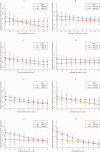Early Childhood Neurocognition in Relation to Middle Childhood Psychotic Experiences in Children at Familial High Risk of Schizophrenia or Bipolar Disorder and Population-Based Controls: The Danish High Risk and Resilience Study
- PMID: 36548470
- PMCID: PMC10154705
- DOI: 10.1093/schbul/sbac198
Early Childhood Neurocognition in Relation to Middle Childhood Psychotic Experiences in Children at Familial High Risk of Schizophrenia or Bipolar Disorder and Population-Based Controls: The Danish High Risk and Resilience Study
Abstract
Background and hypothesis: Familial high-risk (FHR) studies examining longitudinal associations between neurocognition and psychotic experiences are currently lacking. We hypothesized neurocognitive impairments at age 7 to be associated with increased risk of psychotic experiences from age 7 to 11 in children at familial high risk of schizophrenia (FHR-SZ) or bipolar disorder (FHR-BP) and population-based controls (PBC), and further, impaired functioning in some neurocognitive functions to be associated with greater risk of psychotic experiences in children at FHR-SZ or FHR-BP relative to PBC.
Study design: Neurocognition was assessed at age 7 (early childhood) and psychotic experiences from age 7 to 11 (middle childhood) in 449 children from the Danish High Risk and Resilience Study. The neurocognitive assessment covered intelligence, processing speed, attention, visuospatial and verbal memory, working memory, and set-shifting. Psychotic experiences were assessed through face-to-face interviews with the primary caregiver and the child.
Study results: Set-shifting impairments at age 7 were associated with greater risk of psychotic experiences from age 7 to 11 in children at FHR-SZ. Children at FHR-BP and PBC showed no differential associations. Working memory and visuospatial memory impairments were related to increased risk of psychotic experiences across the cohort. However, adjusting for concurrent psychopathology attenuated these findings.
Conclusions: Early childhood neurocognitive impairments are risk markers of middle childhood psychotic experiences, of which impaired set-shifting appears to further increase the risk of psychotic experiences in children at FHR-SZ. More research is needed to examine longitudinal associations between neurocognitive impairments and psychotic experiences in FHR samples.
Keywords: cognitive functions; preadolescence; psychosis; severe mental illness.
© The Author(s) 2022. Published by Oxford University Press on behalf of the Maryland Psychiatric Research Center. All rights reserved. For permissions, please email: journals.permissions@oup.com.
Figures
References
-
- Linscott R, Van Os J.. An updated and conservative systematic review and meta-analysis of epidemiological evidence on psychotic experiences in children and adults: on the pathway from proneness to persistence to dimensional expression across mental disorders. Psychol Med. 2013;43(6):1133–1149. - PubMed
-
- Kelleher I, Connor D, Clarke MC, Devlin N, Harley M, Cannon M.. Prevalence of psychotic symptoms in childhood and adolescence: a systematic review and meta-analysis of population-based studies. Psychol Med. 2012;42(9):1857–1863. - PubMed
-
- Zammit S, Kounali D, Cannon M, et al. Psychotic experiences and psychotic disorders at age 18 in relation to psychotic experiences at age 12 in a longitudinal population-based cohort study. Am J Psychiatry. 2013;170(7):742–750. - PubMed


